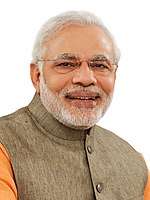Atal Pension Yojana
| Atal Pension Yojana | |
|---|---|
| Country | India |
| Prime Minister(s) | Narendra Modi |
| Key people | prakhar sraban |
| Launched | Original launch in 2010-11. Relaunched on 9 May 2015 |
| Status | active |
| Website |
www |
| ||
|---|---|---|
|
National policy
|
||
Atal Pension Yojana (previously known as Swavalamban Yojana) is a government-backed pension scheme in India targeted at the unorganised sector. It was mentioned in the 2015 Budget speech by Finance Minister Arun Jaitley.[1] It was launched by Prime Minister Narendra Modi on 9 May in Kolkata.[2] As of May 2015, only 20% of India's population has any kind of pension scheme, this scheme aims to increase the number.[3]
History
Swavalamban Yojana was a government-backed pension scheme targeted at the unorganised sector in India. It was applicable to all citizens in the unorganised sector who joined the National Pension Scheme (NPS) administered by the Pension Fund Regulatory and Development Authority (PFRDA) Act 2013.[4][5]
Under the scheme, the Government of India contributed ₹1,000 (US$14) per year to each NPS account opened in the year 2010-11 and for the next three years, that is, 2011-12, 2012-13 and 2013-14. The benefit was available only to people who joined the NPS with a minimum contribution of ₹1,000 (US$14) and maximum contribution of ₹12,000 (US$170) per annum. The scheme was announced by the Finance Minister in Budget 2010-11. It was funded by grants from the Government of India.[4][5]
This scheme has been replaced with Atal Pension Yojana, in which all subscribing workers below the age of 40 are eligible for pension of up to ₹5,000 (US$70) per month on attainment of 60 years of age.
Scheme
In Atal Pension Yojana, for every contribution made to the pension fund, The Central Government would also co-contribute 50% of the total contribution or ₹1,000 (US$14) per annum, whichever is lower, to each eligible subscriber account, for a period of 5 years. The minimum age of joining APY is 18 years and maximum age is 40 years. The age of exit and the start of pension would be 60 years. Therefore, a minimum period of contribution by the subscriber under APY would be 20 years or more.
The national Aadhaar ID number is the primary "know your customer" document for identification of beneficiaries, spouses, and nominees to avoid entitlement-related disputes in the long-term. For proof of address, an individual may submit a copy of their ration card or bank passbook.
The subscribers are required to opt for a monthly pension from ₹1,000 (US$14) to ₹5,000 (US$70) and ensure payment of the stipulated monthly contribution regularly. The subscribers can opt to decrease or increase pension amount during the course of the accumulation phase, as per the available monthly pension amounts. However, the option to switch is only provided once a year during the month of April.
This scheme will be linked to the bank accounts opened under the Pradhan Mantri Jan Dhan Yojana scheme and the contributions will be deducted automatically. Most of these accounts had zero balance initially. The government aims to reduce the number of such zero balance accounts by using this and related schemes.[3] Recently Centre has allowed small finance Banks to offer APY.
See also
References
- ↑ "Jan Suraksha: Social security for masses, pricing woes for insurers", Business Standard, 9 May 2015
- ↑ "Banks advertise Pradhan Mantri Bima Yojana ahead of the roll out", Live Mint, 8 May 2015
- 1 2 "'Jan Suraksha schemes to help eliminate Jan Dhan's zero balance accounts'". Business Standard. 8 May 2015. Retrieved 9 May 2015.
- 1 2 Swavalamban Scheme: Operational Guidelines
- 1 2 FM to launch Swavalamban pension scheme tomorrow
External links
